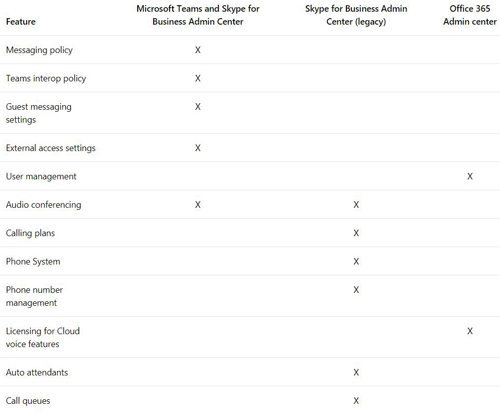News
Teams and Skype for Business Get Joint Management Portal
- By Kurt Mackie
- April 06, 2018
Microsoft's plan to merge Skype for Business Online into its Teams service went another step further this week.
Office 365 subscribers are getting a new management portal with combined controls for both Skype for Business Online and Teams, Microsoft announced Thursday. The new portal is called the "Microsoft Teams and Skype for Business Admin Center."
Microsoft actually started rolling it out to Office 365 subscribers as early as last month. It expects to complete the move in stages for organizations, which will happen "over the next coming weeks."
Some specific management capabilities will be going into the new portal in the first stage of the move, according to Microsoft's announcement.
"As part of this first migration, your existing General, Email integration, Custom cloud storage, Calls and Meetings, and Messaging settings in Microsoft Teams will be moved to the new Microsoft Teams & Skype for Business Admin Center," the announcement explained.
Microsoft plans to move Teams management functions to the new portal in sections. The order of migration will be "Messaging, Meetings, Calls, and lastly, the sections within the TeamsClient Configuration policy (General, Email integration, and Custom cloud storage)," according to this Microsoft document.
Administrators will get informed when a section migration has been completed, and that's when an organization's existing Teams or Skype for Business settings will show up in the new Teams and Skype for Business Admin Center portal. Settings in the older portals will then get disabled.
Transition Phase
During the transition phase toward the new portal, IT pros may need to use the older portals for some management functions. A table in Microsoft's document showed the available capabilities per management portal during the transition period, as follows:
 [Click on image for larger view.] Management features per portal during transition. (Source: Microsoft document.)
[Click on image for larger view.] Management features per portal during transition. (Source: Microsoft document.)
The new portal will eventually replace having to use the Office 365 Admin Center to manage Teams and having to use the Skype for Business Admin Center to manage Skype for Business Online. The move is part of a broader plan. For instance, last year, Microsoft announced plans to bring Skype for Business Online's unified communications features for end users into Teams as part of a so-called "intelligent communications" shift, and now Microsoft is signaling that it's shifting the management tools, as well.
Microsoft also noted this week that it has tutorials available for IT pros to help them learn "how to plan, enable and manage Microsoft Teams."
April Teams Features
End users are getting some new Teams features this month, according to a Thursday announcement by Microsoft. The updates "have rolled out or have started to roll out in the last few weeks," the announcement indicated.
One new perk for IT pros this month is the ability to use .MSI files to remotely install Teams. They can use management tools such as Group Policy, System Center Configuration Manager (SCCM) or "third-party" tools for the deployments. It'll work with Windows 7 clients or newer, according to Microsoft's documentation. That perk comes on top of the new management portal and previously announced capabilities, such as new retention policies and expanded guest access for Teams.
Microsoft has expanded the number of channels permitted per team this month. End users can now "create up to 200 channels per team," inclusive of deleted channels.
With the new April updates, end user contact lists in Skype for Business Online will start showing up in Teams. It'll happen for end users within an organization. Microsoft plans to support "federated contacts from outside your organization" at some later time.
End user presence status will start working across both Skype for Business Online and Teams with the April update. Presence is a capability that provides a notice when a person is away from their desk, for instance. In addition, out-of-office notices will get displayed when end users hover over the "people card" interface in Teams. Out-of-office notices also will show when using the "@ mention" feature, which is a shorthand way of adding people to discussions.
Persistent chat history in Teams will start to show chats from Skype for Business users, both online and on-premises (Skype for Business Server). However, there's a caveat for server users. "For this functionality, the underlying Skype for Business account that is connected to the Teams user needs to be hosted in Skype for Business Online," Microsoft's announcement clarified.
Features such as persistent chat, unified presence, contacts and guest access are also starting to arrive for mobile Android and iOS clients, Microsoft's announcement noted.
Notices about missed calls or new voicemails will start showing up in an end user's activity feed. There's one caveat, though, for missed calls. "Please note that you will only see these notifications if you have a calling plan," the announcement noted. Possibly, that means you need Calling Plans, an optional Skype for Business Online add-on service.
About the Author
Kurt Mackie is senior news producer for 1105 Media's Converge360 group.